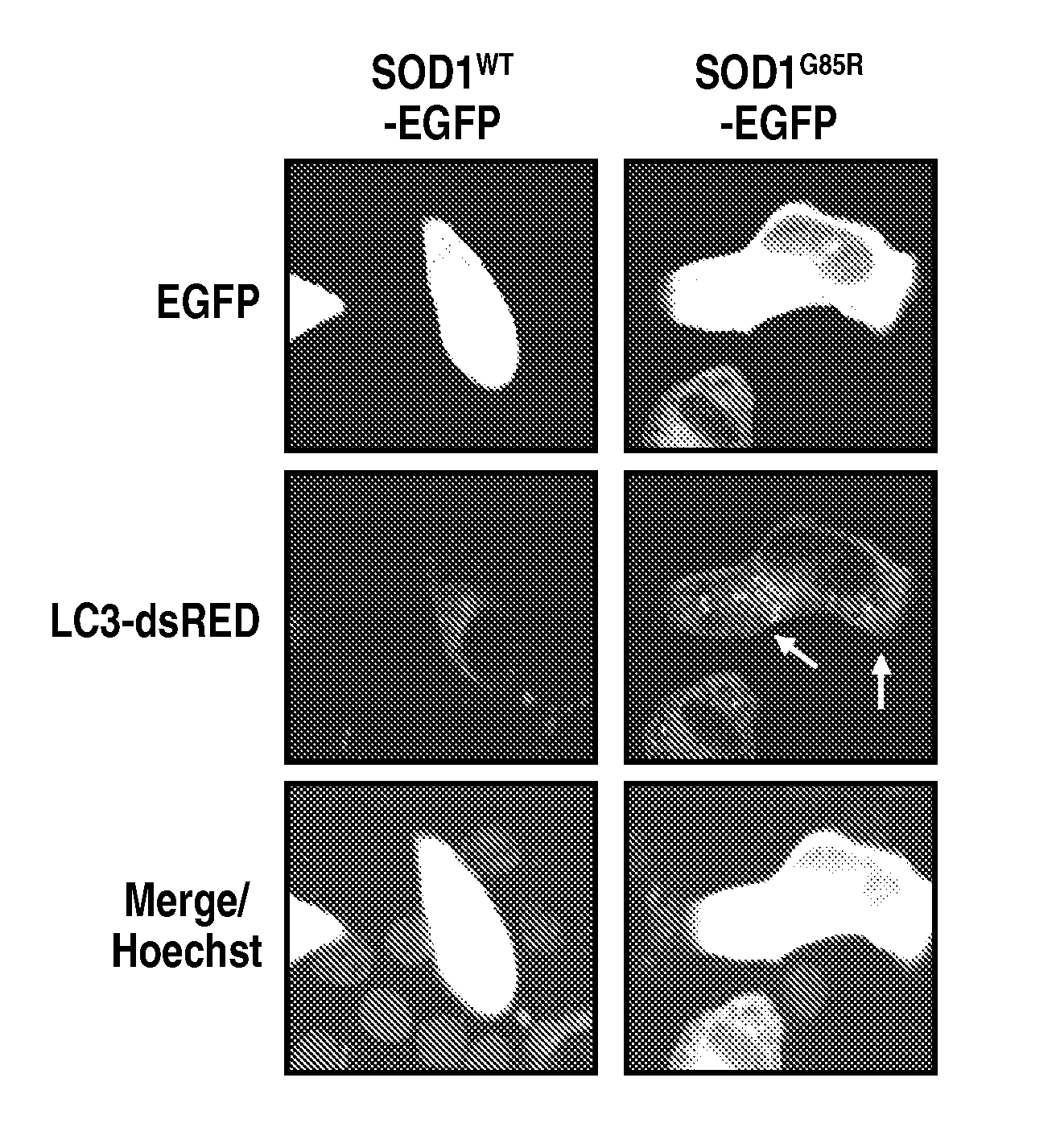Modulation of neurodegenerative disease by modulating xbp-1 activity
- Summary
- Abstract
- Description
- Claims
- Application Information
AI Technical Summary
Benefits of technology
Problems solved by technology
Method used
Image
Examples
example 1
Activation of the UPR in Sporadic and Familial ALS
[0483]To define the contribution of the UPR to ALS, the expression levels of different UPR markers in post-mortem spinal cord samples from sALS and fALS patients was analyzed. Very marked expression of the UPR transcription factors XBP-1s and ATF4 in both sALS and fALS cases (FIG. 1A) was observed. Consistent with this result, classical UPR target genes such as Grp94, Grp78 / BiP and Grp58 were induced (although to variable degrees) in the disease but not control samples (FIG. 1A). Other stress component proteins including eIF2α and phosphorylated ERK were also upregulated in ALS and fALS spinal cord (FIG. 1A). Consistent with these results, increased expression of the XBP-1s target EDEM 1 was observed. These results indicate that ER stress responses are active in both sALS and fALS.
[0484]In order to investigate the functional role of the UPR in ALS, the expression levels of different UPR markers were analyzed in two different mutant S...
example 2
XBP-1 Deficiency Prolongs Lifespan in SOD1 Transgenic Mice
[0485]To study the contribution of the UPR to fALS in vivo, an XBP-1 conditional knockout model was generated in which xbp-1 was deleted in the nervous system using the Nestin-Cre system (XBP-1Nes− / −) (Hetz et al., 2008. Proc. Natl. Acad. Sci. U.S. A 105, 757-762). These mice developed normally and did not show any spontaneous disease. XBP-1Nes− / − mice were cross-bred with SOD1G86R transgenic mice to evaluate the role of XBP-1 in disease onset and animal survival. Surprisingly, XBP-1 deficiency resulted in an increase in life span of SOD1G86R mice from a median survival of 110 days to 120 days (FIG. 2A). Of particular interest, the protective effects of XBP-1 deficiency were markedly accentuated in female animals (FIG. 2B), as evidenced by a highly significant increase of 21 days in life span (p=0.0019), with an average survival of 110 and 132 days for XBP-1WT- and XBP-1Nes− / −-SOD1G86R mice, respectively. These results correl...
example 3
Targeting IRE1α and XBP-1 Decreases Mutant SOD1 Aggregation and Toxicity
[0486]To better define the role of XBP-1 and IRE1α in SOD1 pathogenesis, the expression of xbp-1 and IRE-1 alpha was reduced in NSC34 cells, a well established motoneuron cell line, using lentiviral delivery of small hairpin RNAs (shRNA) (termed shXBP-1 and shIRE1 cells, respectively). This method led to an efficient decrease of XBP-1s expression in cells undergoing experimental ER stress triggered by tunicamycin treatment (FIGS. 3A and B). In addition, knockdown of XBP-1 had a functional effect since the transcriptional upregulation of many UPR-target genes was significantly decreased (FIG. 3C). XBP-1 independent genes such as chop and grp94 were not affected. To monitor SOD1 misfolding in these cells, human SOD1WT or the mutants SOD1G93A and SOD1G85R were transiently expressed as EGFP fusion proteins and the accumulation of intracellular SOD1 inclusions was examined by fluorescent microscopy (FIG. 3D). Interes...
PUM
| Property | Measurement | Unit |
|---|---|---|
| Ratio | aaaaa | aaaaa |
| Content | aaaaa | aaaaa |
| Stress optical coefficient | aaaaa | aaaaa |
Abstract
Description
Claims
Application Information
 Login to View More
Login to View More - R&D
- Intellectual Property
- Life Sciences
- Materials
- Tech Scout
- Unparalleled Data Quality
- Higher Quality Content
- 60% Fewer Hallucinations
Browse by: Latest US Patents, China's latest patents, Technical Efficacy Thesaurus, Application Domain, Technology Topic, Popular Technical Reports.
© 2025 PatSnap. All rights reserved.Legal|Privacy policy|Modern Slavery Act Transparency Statement|Sitemap|About US| Contact US: help@patsnap.com



